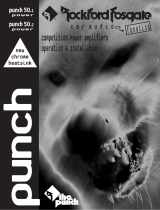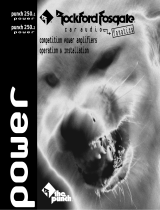Page is loading ...

PA600
PA1000
PA1500
PA2000
PROFESSIONAL POWER AMPLIFIERS
OWNERS MANUAL AND INSTRUCTION GUIDE

Thank you for choosing the L2 audio PA professional power amplifier. We’re confident that your
purchase will give you years of service and the high quality of sound reproduction that our
customers have come to expect. We pride ourselves in designing the right product for the right
application. We have listened to our customers and have designed what we consider to be the
best product in both performance and value for money that is available on the market today.
Please take some time to read this manual and then keep it somewhere safe for future reference.
Also, here at L2 audio, we welcome your feedback and information. We like to know what you’re
using your L2 audio product for!
Please take a few minutes to register your purchase online at www.l2audio.co.uk/warranty
within 14 days of purchase. Failure to do so could affect your warranty. This information is for
our information only and will not be passed on to any third party. Complete customer
satisfaction is our goal at L2 audio. If you have any questions, technical or otherwise please drop
us an email at [email protected].
Once again, many thanks for your purchase.........
The L2 audio team.


Front Panel Controls and Features
1. LEVEL controls adjust signal levels for channels A and B.
2. Status LEDS indicate the following:
·
SIGNAL indicates a signal is present and sound should be heard from the
Speakers providing the level controls have been turned up.
·
CLIP indicates that maximum output power has been reached. Increasing
the level control or input signal will not increase the output power.
·
PROTECT indicates at the point of switching the amplifier on for a few seconds. Once they
have turned off the amplifier is ready for normal operation. If at any stage, they stay
illuminated, a fault has occurred. See section under PROTECT LEDs for more information.
·
BRIDGE indicates the amplifier is in BRIDGE mode
·
RESET
3. POWER switch.
4. FAN ventilation holes. Do Not Obstruct.
Rear Panel Controls and Features
1. There are two INPUT CONNECTORS per channel. One is a combination 3 pin XLR and 3 pole
(TRS) ¼" jack socket, the other a male XLR for linking to other amplifiers. Both balanced and
unbalanced signals can be used to drive the amplifier.

2. Input GND LIFT (ground lift) switch removes the ground connection to all input connectors.
This can solve hum loop problems when connecting equipment with different A.C. supplies.
Under no circumstances should the electrical safety ground (earth) from the A.C. supply be
disconnected.
3. PARALLEL INPUTS links Channel 1 input to Channel 2. A single input signal will now supply
both channels. The volume levels of each channel can still be adjusted individually.
4. 35Hz HIGH PASS FILTER reduces the level of very low frequency signals reaching the
speakers, improving bass clarity and power handling. It is recommended that this filter is
always used for live P.A/Sound reinforcement. Ported / Vented / 'bass reflex' speaker
cabinets can be damaged if driven with high power low frequency. The filter has an 18dB /
octave roll off slope.
5. LIMITER OFF disables the clip limiter circuit. At maximum power output, the limiter virtually
prevents amplifier clipping, minimising audible distortion. It should only be turned off in
specific applications, as serious speaker damage can occur if the amplifier is allowed to
clip regularly.
6. X-OVER turns on the internal two way crossover circuit. The crossover splits the audio band
into high frequencies, suitable for mid/high speakers and low frequencies suitable for bass
speakers. If the crossover function is not required this switch should remain off (out
position).(Not applicable to PA600).
7. The FREQUENCY switch selects the crossover frequency between 150Hz and 100Hz. For
most systems 150Hz is recommended but sometimes, typically when using 18" subs, will
work better with 100Hz.
8. HI LO selects which signal from the crossover the amplifier receives. When HI (out position)
is selected only frequencies above 100 or 150Hz feed the amplifier. When LO (in position) is
selected only frequencies below 100 or 150Hz feed the amplifier.(Not applicable to PA600).
9. XOVER OUTPUT sockets allow the high or low frequencies from the crossover circuit to
feed additional amplifiers. (Not applicable to PA600).
10. BRIDGE mode combines the output power of both amplifier channels into one load. This is
useful when driving a single, high powered speaker. Only channel1 output socket connects
to the speaker but needs to be wired +1 and +2.
11. SPEAKER OUTPUTS. Each channel uses SPEAKON NL4 connectors. Always ensure speaker
cables are wired the same way otherwise the speakers will be out of phase which results in
a slight loss of bass response.
12. CIRCUIT BREAKER will only activate if the amplifier has developed a fault or been driven
too hard. The button on the circuit breaker will protrude about ¼” (6mm) when tripped.
Check speaker wiring and load before re-setting. To reset turn off the amplifier power
switch and push in the reset button. If the breaker trips again, the amplifier could have
developed a fault. If this happens refer the amplifier to a qualified service technician.

13. A.C. POWER inlet.
14. FAN VENTILATION HOLES. Do not obstruct. It is advisable to try and keep a 1U space above
and below the amplifier if it is in a flight case.
Operation
Decide the required mode for the amplifier and select the appropriate rear panel switches.
Always ensure that all signal and power connections to the amplifier are properly made before
switching on. It is advised to make sure that the level controls are set to minimum. Any amplifier
(s) in a system should always be switched on last (with volume down) and switched off first (with
volume down) to prevent any pop or noise originating from other equipment.
Make sure that the speakers being used have the correct power rating for the amplifier. This will
help avoid possible damage to the speakers.
Always use the LIMITER (rear panel switch in the out position) as it helps prevent distortion on
large signal peaks.
Use the 35Hz filter (rear panel switch 'in' position) as it will improve the bass power handling and
clarity of the system. This is especially important with vented / ported / 'bass reflex' cabinets.
When used with a pro-audio mixer, adjust the level controls to a position compatible with the
mixer metering. A suggested starting position for the level controls is '-10' dB.
VENTILATION IS IMPORTANT!
In some installations, racks are fitted with covers for security reasons. If these restrict the air flow
in any way they must be removed while the amplifier is in operation. Where multiple amplifiers
are installed in a rack, additional forced ventilation or a source of fresh cooling air may be
required. Always try and keep some space around the amplifier if it is rack mounted. Ideally a
unit space should be left around the amplifier for air circulation.
Protect LEDs operate independently and show that the speaker outputs have been muted
resulting in no sound. They illuminate under the following conditions:
When the amplifier is turned on. After a couple of seconds the LEDs will turn off showing normal
operation.
If the amplifier has reached an over temperature condition the volume of one or both channels
will rapidly reduce resulting in little or no sound. Once the fans cool down the heat sinks, normal
operation will resume. However, if the transformer has overheated then it may take longer to
cool. If a fault has occurred on one or both channels the relevant PROTECT LED(s) will stay
illuminated and there will be no output. The amplifier should be returned to an Authorised
service centre, in the original packaging if possible, to prevent shipping damage. (See point 5 in
our warranty T&C).S
Cables
Speaker cables should be as short and as heavy gauge as possible to prevent unwanted power
loss caused by high resistance, which can result in loss of both signal level and quality. Heavy
duty, twin core A.C. power cable is generally suitable. A minimum cable requirement is 1.5mm is
recommended. Typically a 10mt speaker lead with 1.0mm cable will lose over 4% into an 8 ohm
load! KNX cables from MGD are chosen for their high quality performance.

SPECIFICATION PA600 PA1000 PA1500 PA2000
Power Output (watts
per channel) @5% THD
X2 8Ω@1KHZ 200W 300W 500W 630W
X2 4Ω@1KHZ 310W 520W 780W 1080W
Bridged 8Ω@1KHZ 620W 1040W 1560W 2160W
Input sensitivity 0dBV 0dBV 0dBV 0dBV
THD@20Hz-20KHz 0.1% 0.1% 0.1% 0.1%
Frequency response 20Hz-20KHz
+0~-0.5dB
20Hz-20KHz
+0~-0.5dB
20Hz-20KHz
+0~-0.5dB
20Hz-20KHz
+0~-0.5dB
SNR ≥95dB ≥95dB ≥95dB ≥95dB
Crosstalk ≥70dB ≥70dB ≥70dB ≥70dB
Damping factor >200 >200 >200 >200
Crossover N/A Selectable
100Hz/150 Hz
2nd order filter
Selectable
100Hz/150 Hz
2nd order filter
Selectable
100Hz/150 Hz
2nd order filter
Input Filter 35Hz 3rd order
filter 18dB/oct@-
3dB
35Hz 3rd order
filter 18dB/
oct@-3dB
35Hz 3rd order
filter 18dB/
oct@-3dB
35Hz 3rd order
filter 18dB/
oct@-3dB
Input Impedance 10K Unbal
20K Bal
10K Unbal
20K Bal
10K Unbal
20K Bal
10K Unbal
20K Bal
Voltage Gain 30dB 32dB 35dB 37dB
Cooling Fan (Controlled by a
45Ԩ temperature
switch, below 45Ԩ
the fan speed is
zero.)
Fan (Controlled
by a 45Ԩ
temperature
switch, below
45Ԩ the fan
speed is zero.)
Fan (Controlled
by a 45Ԩ
temperature
switch, below
45Ԩ the fan
speed is zero.)
Fan (Controlled
by a 45Ԩ
temperature
switch, below
45Ԩ the fan
speed is zero.)
Protection Full short circuit,
open circuit,
thermal, ultrasonic
and RF ,DC
protection,
Full short
circuit, open
circuit, thermal,
ultrasonic and
RF ,DC
protection,
Full short
circuit, open
circuit, thermal,
ultrasonic and
RF ,DC
protection,
Full short
circuit, open
circuit, thermal,
ultrasonic and
RF ,DC
protection,
Amp Type(class) A/B A/B H H
Weight(net weight) 9.7Kg 12.4kg 19kg 22kg
Dims (WxHxD)
(clear dimension)
(Unit : mm)
292*482*88 312*482*88 462*482*88 462*482*88

WARRANTY TERMS AND CONDITIONS
1. L2 Audio is exclusively distributed by the MGD group limited (hereinafter referred to as
‘MGD’)
2. MGD or any MGD authorised agent warrant that the products supplied are free from
defective material or workmanship. This warranty is for a period of one year from date of
purchase. (Exceptions are listed in points 6 & 7)
3. The product should be registered within 14 days of purchase. There is a dedicated on line
form at www.l2audio.co.uk/warranty. If you are not able to register online, please
contact MGD at the address below within 14 days of purchase.
4. Your warranty is a RTB (return to base) warranty. In the unlikely event that your product
needs to be returned, please initially contact your place of purchase to obtain a returns
advice number. We will however always try first to establish if the fault can be rectified
without returning the product.
5. Every effort must be made to retain the original packaging. Any return not in original
packaging is more susceptible to transit damage. Any subsequent claim may be invalidated
due to insufficient packaging. MGD is not liable for any goods sent back that are received
damaged.
6. The warranty does not apply to any misuse, modifications, accidental damage, wear and
tear, neglect or loss occurred during transit.
7. Mains leads and batteries (rechargeable or other) are not covered under this warranty.
Please refer to ‘Battery care’ section of this manual for further information.
8. Your statutory rights are not affected.
C/O MGD Group Ltd
11 Pentrich Road
Giltbrook Trade and Industrial Park
Nottingham NG16 2UZ
England
E&OE
/



